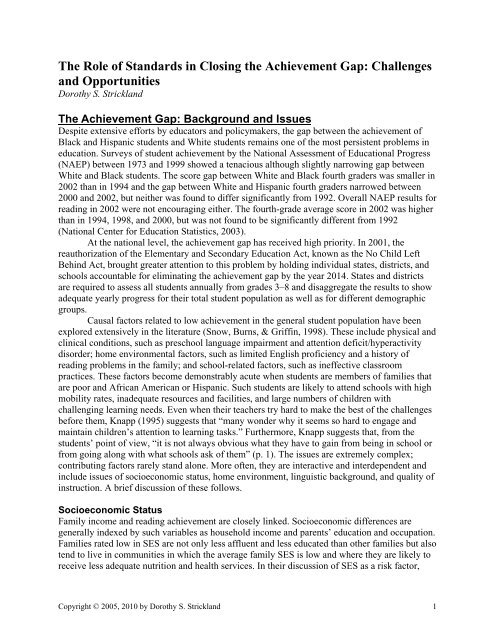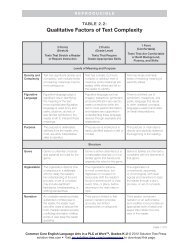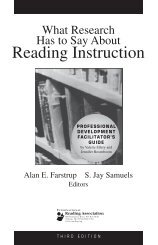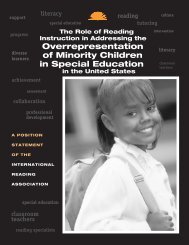Dorothy Strickland - International Reading Association
Dorothy Strickland - International Reading Association
Dorothy Strickland - International Reading Association
Create successful ePaper yourself
Turn your PDF publications into a flip-book with our unique Google optimized e-Paper software.
The Role of Standards in Closing the Achievement Gap: Challenges<br />
and Opportunities<br />
<strong>Dorothy</strong> S. <strong>Strickland</strong><br />
The Achievement Gap: Background and Issues<br />
Despite extensive efforts by educators and policymakers, the gap between the achievement of<br />
Black and Hispanic students and White students remains one of the most persistent problems in<br />
education. Surveys of student achievement by the National Assessment of Educational Progress<br />
(NAEP) between 1973 and 1999 showed a tenacious although slightly narrowing gap between<br />
White and Black students. The score gap between White and Black fourth graders was smaller in<br />
2002 than in 1994 and the gap between White and Hispanic fourth graders narrowed between<br />
2000 and 2002, but neither was found to differ significantly from 1992. Overall NAEP results for<br />
reading in 2002 were not encouraging either. The fourth-grade average score in 2002 was higher<br />
than in 1994, 1998, and 2000, but was not found to be significantly different from 1992<br />
(National Center for Education Statistics, 2003).<br />
At the national level, the achievement gap has received high priority. In 2001, the<br />
reauthorization of the Elementary and Secondary Education Act, known as the No Child Left<br />
Behind Act, brought greater attention to this problem by holding individual states, districts, and<br />
schools accountable for eliminating the achievement gap by the year 2014. States and districts<br />
are required to assess all students annually from grades 3–8 and disaggregate the results to show<br />
adequate yearly progress for their total student population as well as for different demographic<br />
groups.<br />
Causal factors related to low achievement in the general student population have been<br />
explored extensively in the literature (Snow, Burns, & Griffin, 1998). These include physical and<br />
clinical conditions, such as preschool language impairment and attention deficit/hyperactivity<br />
disorder; home environmental factors, such as limited English proficiency and a history of<br />
reading problems in the family; and school-related factors, such as ineffective classroom<br />
practices. These factors become demonstrably acute when students are members of families that<br />
are poor and African American or Hispanic. Such students are likely to attend schools with high<br />
mobility rates, inadequate resources and facilities, and large numbers of children with<br />
challenging learning needs. Even when their teachers try hard to make the best of the challenges<br />
before them, Knapp (1995) suggests that “many wonder why it seems so hard to engage and<br />
maintain children’s attention to learning tasks.” Furthermore, Knapp suggests that, from the<br />
students’ point of view, “it is not always obvious what they have to gain from being in school or<br />
from going along with what schools ask of them” (p. 1). The issues are extremely complex;<br />
contributing factors rarely stand alone. More often, they are interactive and interdependent and<br />
include issues of socioeconomic status, home environment, linguistic background, and quality of<br />
instruction. A brief discussion of these follows.<br />
Socioeconomic Status<br />
Family income and reading achievement are closely linked. Socioeconomic differences are<br />
generally indexed by such variables as household income and parents’ education and occupation.<br />
Families rated low in SES are not only less affluent and less educated than other families but also<br />
tend to live in communities in which the average family SES is low and where they are likely to<br />
receive less adequate nutrition and health services. In their discussion of SES as a risk factor,<br />
Copyright © 2005, 2010 by <strong>Dorothy</strong> S. <strong>Strickland</strong> 1
Snow, Burns, and Griffin (1998) describe low SES as both an individual risk factor and a group<br />
risk factor. A low-status child in a generally moderate or upper-status school or community is far<br />
less at risk than that same child in a whole school or community of low-status children (p. 124).<br />
School funding plays an important role in the socioeconomic status of schools and<br />
communities. Recent studies have reanalyzed the research on school funding and its influence on<br />
the SES of schools and school districts. Biddle and Berliner (2003) analyzed the average annual<br />
expenditures per student for each of the United States and the variation among districts in total<br />
revenues per student within each state. They found that while the disparities in funding differ<br />
sharply among the states, they were greater within some states than among the states as a group.<br />
Unlike the Coleman Report (1972), which reported that school quality (and level of school<br />
funding) had little-to-no impact once home and peer factors were taken into account, Biddle and<br />
Berliner state that funding inequities do make a difference (p. 8).<br />
Home Environment<br />
Even before children enter kindergarten, the achievement gap is in place. The U.S. Department<br />
of Education’s Early Childhood Longitudinal Study (ECLS-K; 2000) shows that by the time<br />
children are five years old, there is a gap in school-related skills and knowledge between African<br />
American and European American children, even when their mothers have equal years of<br />
schooling (it is important to keep in mind that the quality of the mothers’ schooling is not<br />
factored into these measures). Phillips (2000) analyzed several gap-related surveys in an attempt<br />
to describe age-related changes in the Black-White gap as children move through the grades:<br />
Taken together, we estimate that at least half of the black-white gap that exists at the end of<br />
twelfth grade can be attributed to the gap that already existed at the beginning of first grade. The<br />
remainder of the gap seems to emerge during the school years. (p. 136)<br />
Although little is known about the child-rearing practices that may affect children’s<br />
school performance during the upper elementary years and beyond, it may be safe to say that<br />
differences (not deficits) in child-rearing practices may contribute to the gap. Explanations such<br />
as that offered by Ogbu (2002) attribute much of the problem to Black youth cultural patterns<br />
and behaviors that are counterproductive for academic success. Other researchers dispute this<br />
conclusion. Ferguson (2002) speculates that what Ogbu observed was “a clumsy attempt by<br />
black students to search for a comfortable racial identity.” Indeed, as preadolescent and<br />
adolescent students attempt to find their place in society, their personal goals and behaviors often<br />
diverge from what the school expects and demands. When these students come from cultural<br />
backgrounds that differ greatly from that of the school, their attempts to “find their place” may<br />
put them at risk of missing out on important educational experiences offered by schools and<br />
society.<br />
Linguistic Background<br />
The low achievement of poor African American and Hispanic children has often been associated<br />
with their dialect or language. During the 1960s, linguists looked closely at language diversity as<br />
a cause of school failure. Those studies revealed key principles of language learning that remain<br />
helpful to teachers and curriculum developers: All language varieties are equally valid; all<br />
language varieties can accommodate all levels of thought; and any variety of standard English is<br />
not intrinsically better than any nonstandard dialect (Gopaul-McNicol, Reid, & Wisdom, 1998,<br />
p. 7). Similarly, research in the language development of children for whom English is a second<br />
Copyright © 2005, 2010 by <strong>Dorothy</strong> S. <strong>Strickland</strong> 2
language supports the belief that the learner’s home language should be valued and accepted as<br />
part of second language acquisition and learning.<br />
This does not deny the fact that the form language takes has economic, social, and<br />
political importance. Nor does it suggest that helping students achieve competence in Standard<br />
English is not an important goal of the school. It does suggest that much of the low achievement<br />
of language-minority students may be pedagogically induced or exacerbated and therefore<br />
amenable to change (Rueda, 1991). Perhaps most important is the need to keep in mind that all<br />
children learn the language to which they have been exposed. The tendency to equate the use of<br />
language other than Standard English with incompetence must be resisted (<strong>Strickland</strong>, Ganske, &<br />
Monroe, 2002).<br />
The intermediate grades provide an excellent time to guide children in an exploration of<br />
various languages and dialects. Preadolescent children are capable of comparing and contrasting<br />
various ways to express ideas, both orally and in writing. They can also begin to make judgments<br />
about when certain forms of language may be more appropriate than others. Expanding<br />
children’s language repertoires to accommodate a wider range of situations and linguistic<br />
capability should be the ultimate goal.<br />
Quality of Instruction<br />
Many researchers have turned their attention to what is increasingly considered to be a key factor<br />
contributing to the achievement gap—the differences in the quality of instruction that students<br />
receive. According to Haycock (2001), rather than focus on poverty and parental education, we<br />
should begin to concentrate on what takes place in the classrooms that minority students attend.<br />
The problems listed by Haycock include the following: students in high-poverty and highminority<br />
schools are not being challenged; minority students are placed in low-level classes with<br />
a curriculum that does not prepare them for college; no provision is made for students who<br />
require more time and instruction to get on grade level; teachers are often not qualified in the<br />
subjects that they teach; schools with 90 percent greater enrollment or minority students have a<br />
high percentage of underqualified teachers than predominantly White schools. Other researchers<br />
(Darling-Hammond & Hudson, 1989; Ferguson & Brown, 1998) have linked teacher quality with<br />
student achievement and called for a look at both teacher quality, and teaching quality.<br />
The Achievement Gap and Standards<br />
All too often, educators tend to deal with complicated problems by rank-ordering the issues and<br />
dealing with them one at a time. The failure to close the achievement gap may be telling us that<br />
such a linear approach is not the best strategy for addressing the achievement gap (Singham,<br />
2003). Indeed, the value of standards, as a critical element in closing the achievement gap, must<br />
be viewed as one important part of a complex web of possible solutions. Following are several<br />
ways that standards can positively influence schools where students are low achievers.<br />
Promoting a Shared Vision<br />
Stability and sense of mission is important in any school community. It is often missing in low-<br />
SES schools. The process of setting standards or aligning local standards with existing state or<br />
nationally generated standards can inspire teachers and administrators to seriously consider their<br />
goals and commitments to students. Viewing standards as part of an overall mission statement<br />
can provide new teachers with a better sense of what the school expects from them and what they<br />
should expect from students. Teachers who have grown accustomed to teaching particular<br />
Copyright © 2005, 2010 by <strong>Dorothy</strong> S. <strong>Strickland</strong> 3
content in set ways may have to rethink what and how they teach. In situations where the teacher<br />
turnover is great, this is particularly important, though it will take time and it may produce a<br />
degree of anxiety for some. Mentor teachers and literacy facilitators, whose job it is to assimilate<br />
new staff into the system, can use the standards as a springboard for discussing a variety of<br />
curriculum and instructional issues.<br />
Creating a More Focused and Coherent Curriculum<br />
Student mobility, even within the same school district, is often a key deterrent to student<br />
achievement. Standards can provide the impetus for schoolwide curriculum reform. While a rigid<br />
curriculum is not desirable, some degree of curricular consistency within a school and across<br />
schools within a district is helpful for students and teachers alike. The creation and<br />
implementation of a thoughtfully crafted and consistent set of standards can motivate faculty and<br />
administrators to take a serious look at the existing curriculum—a realistic look at what students<br />
need to know and what they bring to the task and the existing disparities that need attention.<br />
Having a well-constructed and well-understood set of standards can provide the credible<br />
evidence for needed resources and planning for professional development.<br />
Linking to Levels of Performance and Assessment<br />
Setting high, yet realistic, goals for students is a constant concern in settings where there is<br />
chronic student failure. Schools with low achievement are frequently told that their expectations<br />
are too low. Standards can be used to go beyond stating what children should learn and be able to<br />
do. They can set levels of performance, which can be adjusted at the district and school levels, if<br />
necessary. Schools can use standards to set benchmarks for “how good is good enough” at<br />
various critical points in a student’s development. Mechanisms for monitoring student growth<br />
can be put in place with provisions for intervention for students and for the professional<br />
development of teachers. Teachers need not lower their expectations. On the contrary, they and<br />
their students must have a clear sense of what is expected and then use instructionally<br />
appropriate practices to move from present levels of performance toward increasingly higher<br />
goals.<br />
Linking standards with assessment is important but may have unintended consequences<br />
in low-performing schools. Schools where academic achievement is low are under great pressure<br />
to raise test scores. High standards and test performance are often equated, resulting in large<br />
amounts of instructional time devoted to teaching directly to summative standardized<br />
evaluations. Using standards to teach to the underlying skills and strategies required to meet<br />
them provides the assessment link that is most likely to ensure better teaching and learning.<br />
Links should be made to ongoing, formative teacher assessment and student self-assessment in<br />
the classroom, rather than summative evaluation.<br />
Planning and Implementing Long-Term Professional Development<br />
Both teacher quality and teaching quality are critical issues in schools where students are not<br />
achieving well. These schools are likely to have more beginning teachers or teachers who are not<br />
certified to teach in the area to which they are assigned. The creation and implementation of<br />
standards can be the springboard for a program of “ongoing” professional development at the<br />
district and school levels. This kind of professional development can have effects beyond that of<br />
upgrading teacher skills to provide a supportive professional atmosphere in which teachers are<br />
more likely to choose to remain in a difficult school.<br />
Copyright © 2005, 2010 by <strong>Dorothy</strong> S. <strong>Strickland</strong> 4
Making the Case for Needed Resources<br />
The lack of adequate resources is frequently presented as a major cause of the achievement gap.<br />
The wide disparity in school funding across and within states has already been discussed.<br />
Standards have the potential to encourage states and districts to provide resources needed for<br />
students to meet them. The case to be made must go beyond setting standards, however, to<br />
include teachers’ and administrators’ understanding and active use of them to promote student<br />
achievement. This can provide the basis for a persuasive argument to school boards and<br />
legislative bodies.<br />
Opportunities and Challenges<br />
Used wisely, standards provide an opportunity to be a catalyst for change in schools where<br />
students are performing poorly. Yet, standards are only one part of the equation. The context in<br />
which they are implemented can make a huge difference. Standards are meant to address<br />
students’ cognitive development. They can provide a framework for quality instruction.<br />
However, it is unlikely that they will have an impact unless the school environment is<br />
emotionally safe and unless there is a sense of community. For preadolescents, how instruction is<br />
delivered may be as important as what is delivered. The intermediate grades may be the last<br />
opportunity for some children to become engaged with schooling. Indeed, many are already<br />
beginning to drop out intellectually, if not physically. For standards to serve intermediate<br />
children well, they must be framed and implemented with the broader framework of instruction<br />
in mind. Fourth and fifth graders need environments that nurture all the pathways by which they<br />
learn.<br />
References<br />
Biddle, B.J., & Berliner, D.C. (2003). What research says about unequal funding for schools in<br />
America: Policy perspectives. San Francisco, CA: WestEd.<br />
Coleman, J.S. (1972). The evaluation of equality of educational opportunity. In F. Mosteller &<br />
D.P. Moynihan (Eds.), On equality of educational opportunity: Papers deriving from the<br />
Harvard University Faculty Seminar on the Coleman Report (pp. 146–167). New York:<br />
Vintage Books.<br />
Darling-Hammond, L., & Hudson, L. (1989). Teachers and teaching. In R.J. Shavelson, L.M.<br />
McDonnell, & J. Oakes (Eds.), Indicators for monitoring mathematics and science<br />
education. Santa Monica, CA: The Rand Corporation.<br />
Early Childhood Longitudinal Study (ECLS-K). (2000). Washington, DC: U.S. Department of<br />
Education Office of Educational Research and Improvement.<br />
Ferguson, R.F. (2002, November 30) as reported in The New York Times, p. B11.<br />
Ferguson, R.F., & Brown, J. (1998). Certification test scores, teacher quality, and student<br />
achievement. Paper presented at the Analytic Issues in the Assessment of Student<br />
Achievement conference sponsored by the National Center for Education Statistics,<br />
Washington, DC.<br />
Gopaul-McNicol, S., Reid, S., & Wisdom, G. (1998). The psychoeducational assessment of<br />
Ebonics speakers: Issues and challenges. The Journal of Negro Education, 67, 16–24.<br />
doi:10.2307/2668236<br />
Haycock, K. (2001). Closing the achievement gap. Educational Leadership, 58(6), 6–11.<br />
Copyright © 2005, 2010 by <strong>Dorothy</strong> S. <strong>Strickland</strong> 5
Knapp, M.S. (1995). Teaching for meaning in high-poverty classrooms. New York: Teachers<br />
College Press.<br />
National Center for Education Statistics. (2003). The nation’s report card: <strong>Reading</strong> highlights<br />
2002. Washington, DC: U.S. Department of Education.<br />
No Child Left Behind Act of 2001, Pub. L. No. 107–110, 115 Stat. 1425 (2002).<br />
Ogbu, J.U. (2002, November 30) as reported in The New York Times, p. B11.<br />
Phillips, M. (2000). Understanding ethnic differences in ethnic achievement: Empirical lessons<br />
from national data. In D.W. Grissmer & J.M. Ross (Eds.), Analytic issues in the<br />
assessment of student achievement. Washington, DC: National Center for Education<br />
Statistics.<br />
Rueda, R. (1991). Characteristics of literacy programs for language-minority students. In E.H.<br />
Hiebert (Ed.), Literacy for a diverse society: Perspectives, practices, and policies. New<br />
York: Teachers College Press.<br />
Singham, M. (2003). The achievement gap: Myths and reality. Phi Delta Kappan, 84, 586–591.<br />
Snow, C.E., Burns, M.S., & Griffin, P. (1998). Preventing reading difficulties in young children.<br />
Washington, DC: National Academy Press.<br />
<strong>Strickland</strong>, D.S., Ganske, K., & Monroe, J.K. (2002). Supporting struggling readers and writers:<br />
Strategies for classroom intervention 3–6. Portland, ME: Stenhouse; Newark, DE:<br />
<strong>International</strong> <strong>Reading</strong> <strong>Association</strong>.<br />
Copyright © 2005, 2010 by <strong>Dorothy</strong> S. <strong>Strickland</strong> 6
















